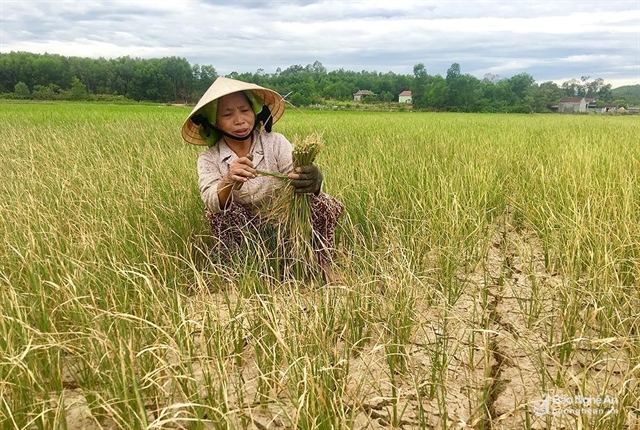 Society
Society

Prolonged hot and dry weather has affected more than 1,200 ha of rice and other crops in the central province of Nghệ An’s Đô Lương District, a local newspaper reported.

|
| Nguyễn Thị Nhường, a farmer from Đại Sơn Commune in Nghệ An Province’s Đô Lương District, picks wilted rice plants to provide food for her buffalo. Photo baonghean.vn |
NGHỆ AN — Prolonged hot and dry weather has affected more than 1,200ha of rice and other crops in the central province of Nghệ An’s Đô Lương District, a local newspaper reported.
As much as 81ha used for aquaculture was also reported damaged, with dead fish lying on the parched ground.
Most reservoirs in the district have hit record lows and are no longer able to supply water to rice paddies.
Nguyễn Thị Nhường, a resident of the district's Đại Sơn Commune, said that despite spending a lot of time preparing the soil, sowing rice and distributing fertiliser, her family’s cultivation of area of 2,520sq.m was gradually dying due to the lack of water.
“Since the prolonged heat has killed many rice cultivation areas, my family and local residents hope the Government will provide some assistance to offset the initial investment,” she told Nghệ An newspaper.
Nhường said she had no choice but to harvest her rice to provide food for her buffalo, adding that she had spent several million đồng on the rice seeds, fertiliser and other expenses.
It was estimated that 254ha out of the commune’s 366ha of rice growing area was threatened by the ongoing drought. Thirteen out of the commune's 14 reservoirs were running out of water.
Due to the extremely low water levels and continuous hot weather, dead fish can be seen along the bottom of Chọ Ràn Reservoir.
Pumps are running at full capacity to supply water for rice cultivation, said Nguyễn Văn Thái, another resident.
Farmers in Hiền Sơn Commune are suffering the same ordeal with 115ha of summer-autumn rice withering because of the drought.
Rú Hối, Hòa Long and Hòa Phú villages have been hardest hit.
Experts said that because the heat is expected to last until September, the amount of destroyed crops will continue to rise. — VNS




